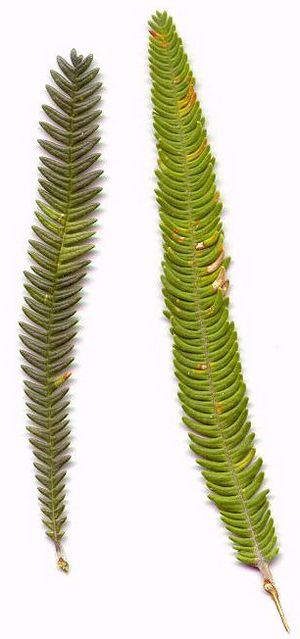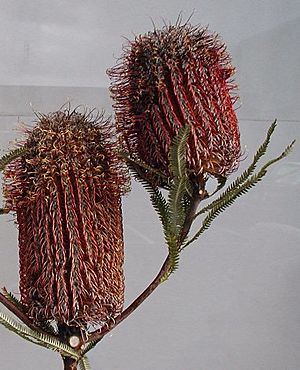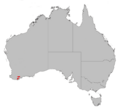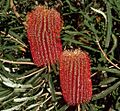Feather-leaved banksia facts for kids
Quick facts for kids Feather-leaved banksia |
|
|---|---|
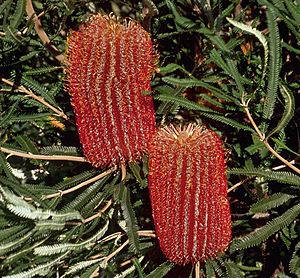 |
|
| inflorescences and leaves. | |
| Conservation status | |
| Scientific classification | |
| Genus: |
Banksia
|
| Species: |
brownii
|
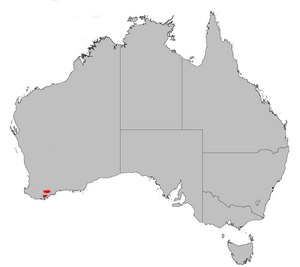 |
|
| Distribution of B. brownii within Australia | |
| Synonyms | |
|
|
The Feather-leaved banksia (Banksia brownii) is a special type of shrub that grows in Western Australia. People also call it Brown's banksia. It's a very attractive plant with soft, feathery leaves and big, reddish-brown flower spikes.
This plant usually grows as an upright bush, about two metres (7 ft) tall. Sometimes, it can be a small tree or a low, spreading shrub. It was first found in 1829.
The Feather-leaved banksia is quite rare and endangered in its natural home. Its biggest threat is a plant disease called Phytophthora cinnamomi dieback. This disease makes the plant's roots rot.
Even though it's endangered, the Feather-leaved banksia is very popular. People in Australia use it in gardens and for cut flowers. It grows best in sheltered spots with good drainage and needs some water in summer.
Contents
What it Looks Like
The Feather-leaved banksia usually grows as an upright bush. It can be between one and three metres (3–10 ft) tall. In protected areas, it might grow into a small tree up to six metres (20 ft) high. In windy places, it stays low and spreads out.
Its bark is smooth, thin, and grey-brown. The leaves are long and thin, about three to ten centimetres (1–5 in) long. They are dark green on top and white and hairy underneath. They look like feathers because they are deeply divided into many thin parts.
The flowers grow in "flower spikes." These are like big, dense brushes made of hundreds of tiny flowers. The flower spikes are a shiny red-brown colour. They are usually 6 to 19 centimetres (2–7½ in) tall.
Each flower has a tube-shaped part and a long, thin, hooked style. The style is rusty red-brown with a cream tip. These flower spikes usually stand upright at the end of a branch.
After flowering, the plant forms a woody "cone." This cone is about five centimetres (2 inches) wide. It looks hairy because of the old flower parts that stay on it. Inside the cone, there can be up to 60 seed pods, called follicles. Each pod usually holds just one shiny black seed. The seed is oval-shaped and has a papery brown wing.
How it is Named and Classified
The Feather-leaved banksia was first collected in 1829. A botanist named William Baxter found it near King George Sound. He named it after another famous botanist, Robert Brown. So, its full scientific name is Banksia brownii Baxter ex R.Br.
Scientists group plants based on their features. Banksia brownii belongs to the Banksia genus. It is part of a group called Banksia subgenus Banksia.
There are three slightly different types of Feather-leaved banksia. One is a "mountain form" which is shrubby and has short, hard leaves. Another is the "Millbrook Road form," which grows like a tree and has longer, softer leaves. There's also an in-between type. These differences are genetic, but they don't have separate scientific names yet.
Where it Lives
The Feather-leaved banksia only grows in a specific part of Western Australia. It is found between Albany and the Stirling Range. This area is cool and wet, with good rainfall.
It grows in two main types of places. In the Stirling Range, it lives on rocky mountain slopes. Further south, it grows in jarrah woodlands. Here, it prefers shallow, sandy soil that doesn't have many nutrients.
There are 27 known groups of these plants. However, only nine of these groups have more than 10 plants. Only five groups have more than 100 plants. Sadly, ten groups are now thought to be gone forever. Experts believe there are only about 1000 plants left in total.
Life Cycle and How it Grows
Feather-leaved banksia plants that grow near the coast start flowering when they are about five years old. Plants in the Stirling Range take much longer to grow up and flower. Some only start flowering after eight years.
They usually flower between March and August, with most flowers opening around June. More flowers open during the day than at night.
Like other Banksia plants, the Feather-leaved banksia makes a lot of nectar. This sweet liquid is a food source for many animals. Birds like honeyeaters, mammals like bush rats, and insects like bees visit the flowers. These visitors help to spread pollen from one flower to another, which helps the plant make seeds.
The plant can make some seeds on its own, but it makes more if animals help with pollination. However, it doesn't make many seeds overall. Less than 1% of its flowers turn into seed pods. Many seeds are also eaten by insect larvae or birds like cockatoos.
Most of the seed pods stay closed until a bushfire happens. The fire kills the plant, but it also makes the pods open and release their seeds. This allows new plants to grow. However, even after the seeds are released, many are eaten by parrots.
Protecting the Feather-leaved Banksia
The Feather-leaved banksia is in great danger. Its biggest threats are:
- Loss of habitat: Land is cleared for other uses.
- Commercial use: People collect too many flowers.
- Disease: Especially the Phytophthora cinnamomi dieback.
- Fire: Fires that happen too often or not often enough.
- Climate change: Warmer temperatures and less rain could shrink where it can live.
The disease called Phytophthora cinnamomi is a huge problem. It's a tiny water mould that lives in the soil. It attacks the plant's roots, causing them to rot. Almost all big groups of Feather-leaved banksia are affected by this disease.
Scientists are trying to protect the plants. They restrict access to infected areas to stop the disease from spreading. They also collect and store seeds in cold places. This is like a "seed bank" for the future. They also treat plants with a chemical called phosphite. Phosphite helps the plants fight off the disease.
Fire is also important for this plant. Fires help the seeds to be released. But if fires happen too often, young plants don't have enough time to grow and make seeds. If fires don't happen often enough, old plants die without releasing their seeds. The best time between fires for this plant is about 18 years.
Because it's so hard to protect the plants in the wild, scientists are also trying to grow them in safe places. Seeds are stored in seed banks in Australia and at Kew in England. Some of these stored seeds have been grown into seedlings and planted in new, disease-free locations. This helps keep the plant's genetic diversity alive.
Growing it in Gardens
The Feather-leaved banksia is very popular for gardens and for cut flowers. This is because of its big, shiny red flowers and soft, feathery leaves. You can buy seeds and plants from nurseries in Australia.
It's best to grow it in a sheltered spot with soil that drains well. It needs some water during summer. It grows quickly but takes a few years to flower. Once it's grown, it can handle light frost and light trimming.
The main challenge is that it's very sensitive to the dieback disease. This disease is common in many suburban gardens. However, people have found a way around this! They can graft the Feather-leaved banksia onto the roots of another Banksia plant, like the Coast banksia (Banksia integrifolia). This makes the plant much tougher and able to grow in more types of soil.
Images for kids
-
inflorescences and leaves.
- Banksia brownii — Brown's Banksia, Feather-leaved Banksia, Species Profile and Threats Database, Department of the Environment and Heritage, Australia.
See also
 In Spanish: Banksia de hojas plumosas para niños
In Spanish: Banksia de hojas plumosas para niños



